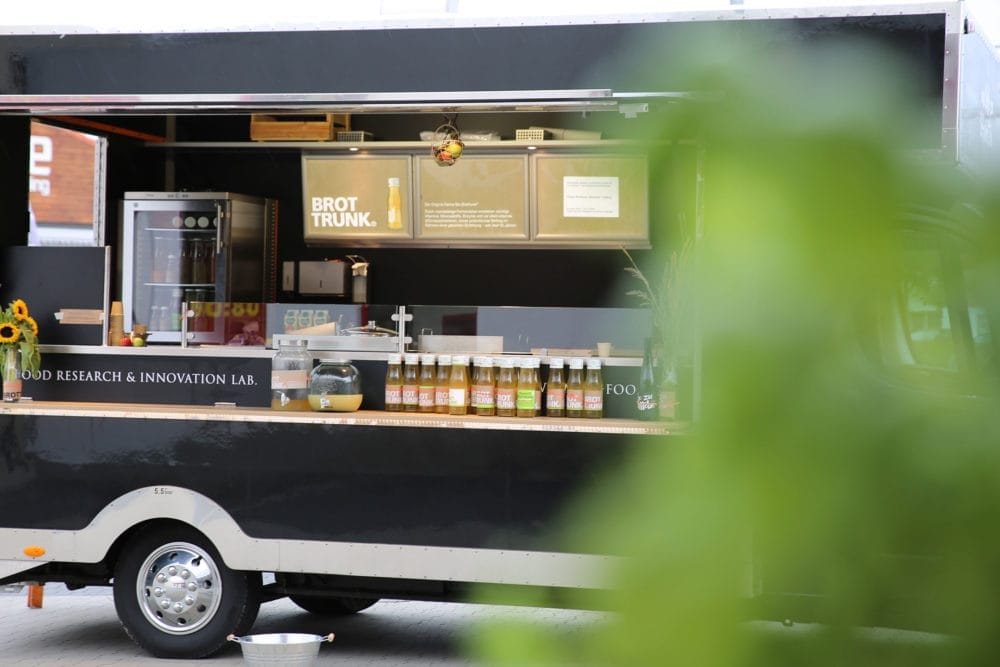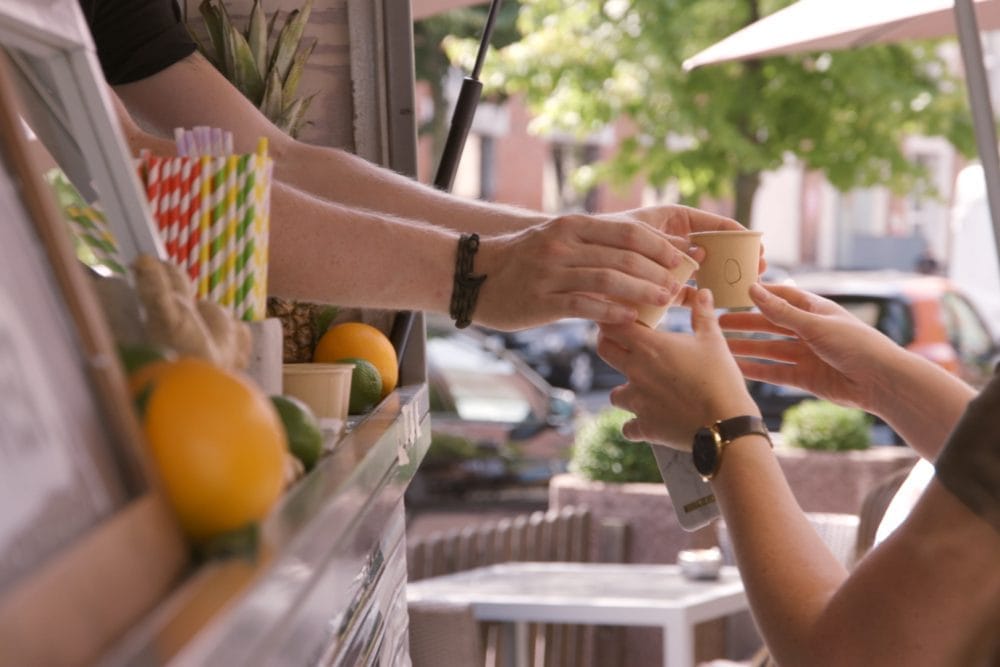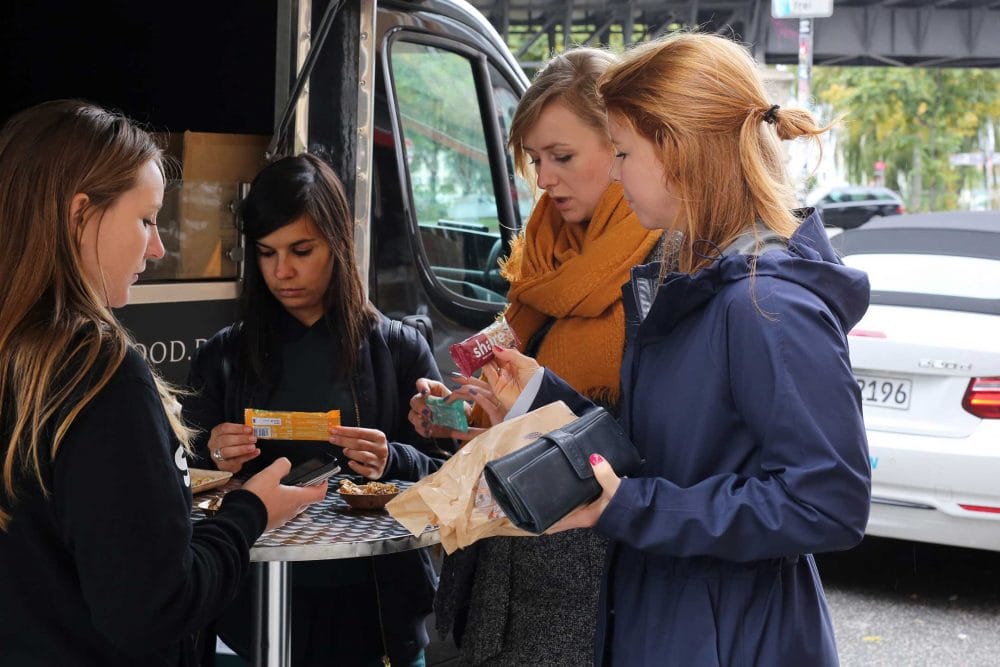HUMAN
CENTERED
DESIGN
Our top tool combines design sprints with prototyping and street research.
Dynamic markets and short product life cycles are forcing our customers to develop products faster than before. That is why we have expanded our range to include a mobile test laboratory for food (concepts, products, packaging): the food truck is a playground for product developers and marketeers.
Our “Top Tool” is a mixture of design sprint, rapid prototyping and street research via food truck. We bring food market research back to the streets! The early tests enable agile design development in targeted steps. Our human-centered design process improves project quality and gives our customers time/cost advantages in their highly competitive and dynamic environment.
Case study: Sipahh
The video documents our design sprint in conjunction with packaging prototyping and agile survey methods for our client Importhaus Wilms. Due to the clearly formulated task and existing brand guidelines, the agile process could be compressed into a few days. The international team from Singapore (Unistraw/Sipahh) and Walluf (Wilms) was welcomed by us at Tatcraft for the packaging design sprint. The results were iteratively improved in two loops via our research process.
Case study: Unilever
The video documents our mobile survey for Unilever (NL/UK). Recipes were tested using our agile approach and packaging designs were presented. The implementation took place over three days and a total of 265 interviews were conducted and analyzed.
Case study: Fritz cultural assets
New Anjola recipes with reduced sugar content were tested at various locations for Fritz Kulturgüter.
Case study: Share
The case study on Share shows the bars before they are launched in the final pre-testing phase for final product range optimization. We met up in Berlin Kreuzberg and supported the start-up in its launch preparations.
Human-centered design: innovation with a focus on real needs
Design starts with people – not with the product. With our human-centered design approach, we put real users at the heart of the development process. We design brands, products and packaging that not only work – but are relevant, understandable and tangible.
Empathy, iteration and co-creation form the basis of our work – from the initial idea through to implementation.
What does human-centered design mean?
Human-Centered Design (HCD) is a user-centered design approach in which people, their needs, wishes and contexts are consistently included in the development process. It is not a ready-made design recipe, but a methodical framework that thinks innovations from the user’s perspective.
Typical for HCD are:
- Empathic understanding of user groups
- Iterative idea development & prototyping
- Early user feedback & continuous improvement
- Interdisciplinary cooperation
The goal: solutions that are intuitive, effective and brand-compliant – because they solve real problems.
Our services in the field of human-centered design
We support companies in the strategic, creative and user-centered development of brand and product experiences:
- Research & empathy phases: User interviews, environment analysis, persona development
- Workshops & co-creation formats: together with stakeholders and target groups
- Ideation & prototyping: rapid visualization and testing of solutions
- Design concepts & packaging approaches: conceived from the user’s perspective and implemented in a brand-specific way
- User testing & optimization: feedback loops before market launch
Where human-centered design is particularly valuable
HCD is particularly effective when products or services are emotionally charged, require explanation or are new – e.g. in the case of:
- Innovative food products & new product categories
- Packaging solutions with a focus on usability, sustainability & comprehensibility
- Repositioning or relaunching brands
- Crosschannel communication & UX-oriented content development
This is where the human-centered approach helps to create relevance instead of just attention.
How does our HCD process work?
We work iteratively and modularly – depending on the project requirements. Our typical process:
- 1st empathy phase: understanding target groups, conducting interviews, analyzing usage contexts
- 2. definition: summarize relevant Insights, formulate design challenge
- 3. ideation: developing creative solutions – collaborative & interdisciplinary
- 4. prototyping: quickly visualize concepts (e.g. packaging dummies, storyboards, scribbles)
- 5. testing & iteration: obtain feedback, develop, improve
This creates solutions that generate real resonance – because they are based on understanding, not assumptions.
Human-centered design meets branding & packaging
Brand communication often starts with the packaging. This is where it is decided whether a product is understood, bought or recognized. That’s why we think HCD not only in terms of the interface, but also in terms of the physical space – on the packaging, at the POS, on the shelf.
We analyze behavior, orientation, expectations and barriers – and design packaging that is intuitive, informative and inviting.
Connection with sustainable brand management
HCD is not just a design process – it is also an attitude towards users, society and the future. This fits perfectly with sustainable brands: People who make conscious purchases expect comprehensible information, ease of use and credible design. Human-centered design provides the methodological foundation for this.
Typical results from our HCD processes
- User-centered packaging solutions (incl. material & structure recommendation)
- Product range launches for new target groups
- Comprehensible claims, icons, on-pack communication
- Persona profiles & design parameters for brand development
- Optimized product navigation & design grid
FAQ – Frequently asked questions about human-centered design
Do you always have to involve users?
Not necessarily. But the more complex or new a topic, the more helpful real feedback is. We also offer “Lean HCD” – with internal personas or expert assessments if time or budget are limited.
Is HCD only for digital products?
No – quite the opposite. We use HCD particularly in the physical space: packaging, products, print, POS, events. Wherever people interact with brands.
Can you also offer just one HCD workshop?
Yes, we offer compact impulse formats, method training or accompanied sprints. This is particularly suitable for innovation or brand projects with an internal team.
How can success be measured?
Through usability tests, market research, conversions or internal feedback. Important: HCD is not an end in itself – it has a direct impact on relevance, comprehensibility and user loyalty.
How long does a typical HCD project take?
From 2-day sprints to 8-week development cycles, everything is possible. We adapt the methodology and depth to your resources and objectives.
Conclusion: Good design starts with good empathy
Human-centered design brings brands closer to people – and people closer to products. In a world full of choices, user relevance is crucial. We help you to find them methodically – and to implement them creatively.





